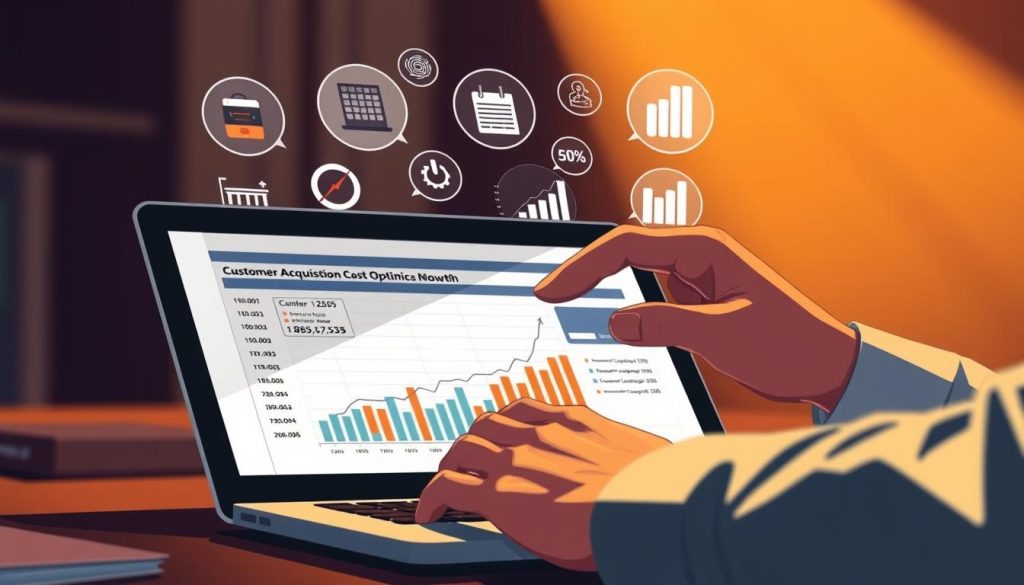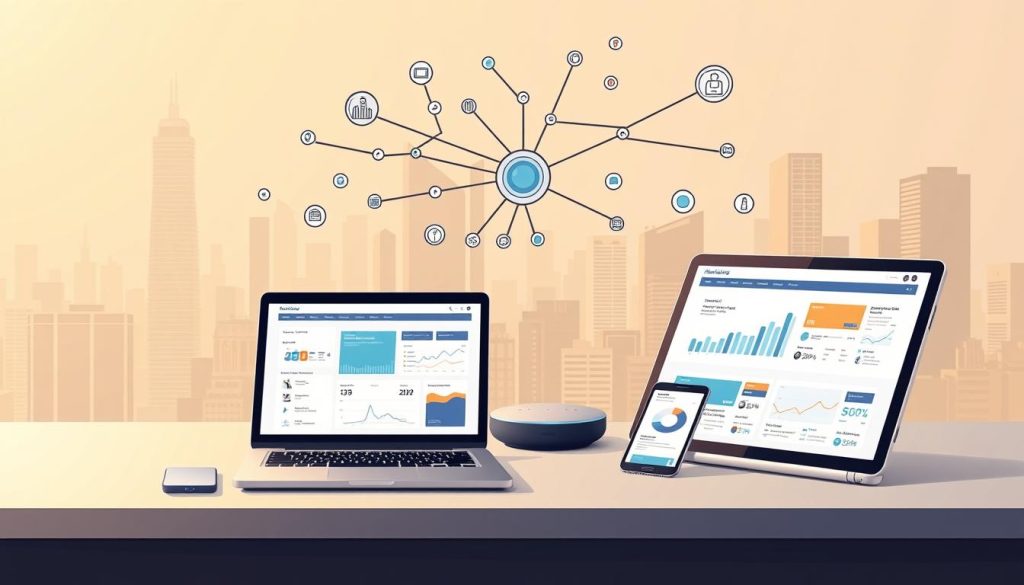What if your growth strategy is missing the one element that turns casual browsers into loyal buyers? While many professionals focus on visibility, true success lies in systematically converting interest into action. This critical process forms the backbone of sustainable expansion, especially for independent workers navigating competitive markets.
Effective growth tactics go beyond basic marketing. They create a clear path from initial discovery to repeated purchases, using data to identify high-value prospects. For instance, referral marketing leverages trusted relationships, with 84% of people valuing personal recommendations over traditional ads.
Our approach combines analytical precision with human insight. You’ll learn to measure what matters, nurture promising leads, and build systems that deliver predictable results. These methods prove particularly valuable for professionals transitioning to self-employment who need reliable income streams.
Table of Contents
Key Takeaways
- Strategic conversion processes outperform generic marketing campaigns
- Data analysis identifies your most profitable audience segments
- Referral systems generate 3x more loyal clients than paid ads
- Clear metrics track progress through each growth stage
- Integrated strategies align with long-term business objectives
Mastering these principles creates a foundation for consistent expansion. The following sections break down actionable techniques refined through years of helping professionals achieve financial independence.
Understanding Customer Acquisition Fundamentals
Building a sustainable business requires more than attracting attention—it demands converting interest into action. This process combines strategic planning with measurable outcomes, creating pathways that turn potential buyers into loyal supporters.
What Is Customer Acquisition?
It’s a structured approach to guiding your target audience from discovery to purchase. Unlike isolated campaigns, it uses sequenced interactions to build trust. Each step demonstrates value, addressing specific needs through tailored communication.
Customer Acquisition vs. Marketing
While marketing focuses on visibility, acquisition drives measurable outcomes. Think of marketing as the spark that starts the fire—acquisition ensures it burns steadily. Below shows how they differ:
| Aspect | Marketing | Acquisition |
|---|---|---|
| Primary Goal | Generate awareness | Secure transactions |
| Timeframe | Short-term campaigns | End-to-end journey |
| Metrics Tracked | Impressions, clicks | Conversion rates, ROI |
| Resource Focus | Content creation | Relationship nurturing |
For independent professionals, this distinction matters. Limited resources should prioritize systems that deliver repeatable results. Effective strategies merge awareness-building with conversion optimization, creating a cycle of sustainable growth.
The Importance of a Solid Customer Acquisition Strategy
Sustainable growth hinges on systems that convert interest into lasting relationships. A structured approach ensures predictable results while adapting to market shifts. Professionals transitioning to self-employment particularly benefit from this stability.
Driving Long-Term Growth
Strategic frameworks outperform temporary tactics. Consider these advantages:
- Predictable revenue: Systematic approaches reduce income fluctuations
- Risk reduction: Diversified client portfolios prevent over-reliance
- Market leadership: Consistent growth builds authority in your niche
« Focusing solely on immediate conversions is like planting annuals. True professionals cultivate perennial systems. »
This table contrasts short-term tactics vs strategic growth:
| Factor | Quick Wins | Strategic Approach |
|---|---|---|
| Revenue Impact | Spikes & drops | Steady upward trend |
| Client Relationships | Transactional | Loyal & recurring |
| Resource Allocation | Reactive spending | Planned investments |
| Market Position | Temporary visibility | Established authority |
Professionals using strategic frameworks report 37% higher retention rates. Momentum builds as each success attracts new opportunities through referrals and reputation. Scalable systems allow expansion into adjacent markets without compromising service quality.
Key metrics shift from lead quantity to relationship depth. This evolution creates cross-selling opportunities while reducing marketing costs over time. The result? A business model that thrives through economic cycles.
The Customer Acquisition Process: A Step-by-Step Overview
Successful growth demands more than random tactics—it requires a structured framework that guides prospects from curiosity to commitment. This three-phase system works across digital and offline channels, creating predictable results for independent professionals.
Phase 1: Sparking Initial Interest
Attract quality leads by addressing specific challenges through targeted content. Educational blog posts, social media Q&A sessions, and free resources position you as a trusted advisor. For example, webinars addressing common industry pain points generate 40% more engaged prospects than generic ads.
Phase 2: Building Trust Through Engagement
Nurture relationships with personalized email sequences and case studies. One consulting firm increased conversions by 28% using tailored follow-ups based on prospect behavior. Regular value delivery turns casual visitors into invested leads.
Phase 3: Sealing the Commitment
Convert ready buyers with time-sensitive offers and frictionless purchasing. Simplified checkout processes and clear ROI demonstrations reduce hesitation. Data shows streamlined systems improve conversion rates by up to 34% compared to complex procedures.
This approach aligns with how modern professionals make decisions—through gradual trust-building rather than impulsive actions. By mapping touchpoints across channels, you create multiple opportunities to demonstrate expertise and value.
Leveraging the Customer Acquisition Funnel
Navigating business growth resembles steering a ship through changing currents—without a reliable map, even skilled captains drift off course. The acquisition funnel provides this essential guidance, structuring how prospects evolve from casual observers to committed partners. By understanding each stage, you create intentional interactions that accelerate decision-making while respecting the buyer’s pace.
Understanding Funnel Stages
Five phases define the journey:
- Awareness: Prospects discover your expertise through blogs, ads, or referrals
- Interest: They engage with case studies or product demos
- Consideration: Comparisons occur—reviews and testimonials weigh heavily
- Intent: Free trials or consultations signal readiness
- Action: Commitments solidify through purchases or contracts
Tailor content to each phase. Educational webinars work early in the funnel, while limited-time offers excel near the end. A marketing agency increased conversions by 22% using this staged approach.
| Stage | Key Metric | Optimization Focus |
|---|---|---|
| Awareness | Traffic volume | Content relevance |
| Interest | Engagement rate | Value demonstration |
| Consideration | Comparison time | Social proof quality |
| Intent | Lead quality | Offer urgency |
| Action | Conversion rate | Process simplicity |
Track metrics like bounce rates and time-to-decision to spot bottlenecks. For instance, if prospects linger in Consideration, boost credibility with third-party certifications. Targeted acquisition strategies become most effective when aligned with these insights.
Smooth transitions between stages prevent drop-offs. Automated email sequences that trigger based on user behavior maintain momentum. This logical progression builds trust while systematically addressing concerns—a proven path to sustainable growth.
Effective Customer Acquisition Methods
Modern professionals need more than generic outreach—they require systems that consistently attract and convert high-value prospects. By combining educational resources with strategic distribution, you create multiple entry points for your ideal audience. This approach builds authority while addressing specific needs at different decision stages.
Content Foundations & Visibility Optimization
Content marketing establishes your expertise through problem-solving guides and case studies. For example, detailed blog posts explaining industry challenges generate 3x more qualified leads than promotional content. Pair this with search engine optimization to ensure your materials appear when prospects seek solutions.
| Content Type | SEO Benefit | Engagement Boost |
|---|---|---|
| How-to Guides | Targets long-tail keywords | 42% longer page stays |
| Video Tutorials | Improves dwell time | 68% share rate |
| Industry Reports | Attracts backlinks | 55% lead capture |
Relationship-Building Channels
Platforms like LinkedIn and specialized forums let you demonstrate expertise through value-driven interactions. Proven social media techniques focus on engagement over follower counts—thoughtful comments outperform generic posts by 27% in lead generation.
Email remains unmatched for nurturing prospects. Automated sequences with personalized recommendations achieve 33% higher conversion rates than batch campaigns. Consider this comparison:
| Channel | Avg. Conversion Time | Cost per Lead |
|---|---|---|
| Social Media | 14-21 days | $8.50 |
| Email Marketing | 7-10 days | $3.20 |
Integrate these methods using shared messaging and performance tracking. Monthly audits help identify top-performing channels, allowing strategic resource allocation. Tools like Google Analytics reveal which content drives conversions, enabling continuous refinement of your approach.
Optimizing Customer Acquisition Costs (CAC)

Smart financial management separates thriving businesses from struggling ventures. Tracking expenses tied to converting prospects reveals opportunities to boost profitability while maintaining growth. Customer Acquisition Cost (CAC) measures every dollar spent to gain one paying client—from ads to team hours.
Mastering the Numbers Game
Calculate CAC by dividing total campaign expenses by new clients acquired. For example: $5,000 spent ÷ 50 conversions = $100 per client. Companies with aligned sales and marketing teams achieve 30% lower costs through shared data and streamlined processes.
| Cost-Reduction Strategy | Impact | Implementation Time |
|---|---|---|
| Channel Performance Analysis | Identifies 20-40% savings | 2-4 weeks |
| Automated Lead Nurturing | Cuts follow-up costs by 55% | 3-6 weeks |
| Referral Incentives | Lowers CAC by 35% | Immediate |
Benchmark against industry averages to spot inefficiencies. Professional services typically maintain CAC ratios below 25% of client lifetime value. Tools like HubSpot track real-time spending across campaigns.
Focus on high-conversion channels like email marketing, which delivers clients at 60% lower costs than social ads. Regular audits prevent budget leaks—one consulting firm saved $18,000 monthly by eliminating underperforming keywords.
« Reducing CAC isn’t about cutting corners—it’s about strategic resource allocation. »
Balance short-term expenses with long-term gains. Clients acquired through educational content yield 28% higher repeat purchases than paid traffic. This approach builds sustainable growth while keeping acquisition costs manageable.
Maximizing Customer Lifetime Value (CLV)
Hidden growth potential often lies in deepening relationships with existing clients. Customer lifetime value (CLV) measures the total revenue your business earns from a client over time. This metric reveals which relationships deserve focused nurturing and where to allocate resources for maximum impact.
Strategies to Enhance Long-Term Client Value
Boost CLV by delivering exceptional service that encourages repeat engagements. A consulting firm increased annual client value by 42% using personalized check-ins and proactive solution suggestions. Regular communication builds trust while identifying upselling opportunities.
Consider these proven methods:
- Educational content: Share industry insights to position yourself as an ongoing resource
- Tiered service packages: Create natural upgrade paths as needs evolve
- Loyalty rewards: Offer exclusive benefits for long-term partnerships
| Strategy | CLV Increase | Implementation Time |
|---|---|---|
| Quarterly Reviews | 18-25% | 2 weeks |
| Cross-Selling | 30-40% | 1 month |
| Referral Programs | 22% | Immediate |
Analyze your CLV-to-CAC ratio monthly. Ratios above 3:1 indicate healthy profitability, while values below 2:1 signal needed adjustments. One accounting professional doubled profits by reallocating budgets from low-CLV segments to high-value clients.
« CLV isn’t just a metric—it’s a compass guiding sustainable business decisions. »
Focus on clients demonstrating growth potential through repeat engagements or referrals. These relationships generate 68% of long-term revenue for most independent professionals. Systematic tracking ensures you recognize and cultivate these valuable partnerships.
Harnessing Digital Tools for Customer Acquisition

Technology reshapes how professionals connect with their audience while maintaining human-centric service. Smart platforms handle repetitive tasks, letting you focus on strategic decisions that drive meaningful results. This balance between efficiency and personalization defines modern growth strategies.
Smart Technology Integration
AI-powered systems analyze engagement patterns to optimize outreach timing and messaging. For instance, machine learning identifies high-potential leads 53% faster than manual methods. These tools adapt based on real-time data, improving campaign performance continuously.
Key platforms include:
- CRM automation: Tracks interactions and triggers personalized follow-ups
- Predictive analytics: Forecasts client needs using historical data
- Chat interfaces: Provides instant responses to common inquiries
| Tool Type | Key Benefit | Time Saved |
|---|---|---|
| Email Sequencing | 27% higher open rates | 9 hrs/week |
| Ad Optimizers | 34% lower CPC | 6 hrs/week |
| Content Assistants | 2x faster blog creation | 12 hrs/week |
Marketing efforts become more precise with automated A/B testing. One consultant increased conversions by 19% using AI-generated subject lines. These systems learn from each interaction, refining their suggestions over time.
« The best tools amplify human skills—they don’t replace them. »
Integration matters. Unified platforms sync data across channels, providing a complete view of prospect journeys. This approach maintains personal connections while scaling operations efficiently.
Implementing Omnichannel Customer Acquisition
Today’s professionals thrive when their growth strategies work seamlessly across every interaction point. An omnichannel approach removes friction between platforms, ensuring your expertise reaches prospects wherever they engage. This method builds momentum by aligning touchpoints—from social media to email—into a cohesive journey.
Integrated Marketing Approaches
Combine digital and traditional channels using shared messaging frameworks. For instance, webinar content can fuel LinkedIn posts, email sequences, and podcast episodes. Data shows businesses using cross-channel strategies achieve 43% higher retention than single-platform efforts.
Key elements include:
- Centralized analytics tracking engagement patterns
- Adaptive content that reshapes for different formats
- Consistent branding across all mediums
Creating a Unified Customer Experience
Personalization drives omnichannel success. A consultant might send tailored follow-ups after a client downloads a guide, referencing their specific industry challenges. Tools like CRM systems maintain context across interactions, making transitions between channels feel natural.
Prioritize effortless transitions—ensure mobile users can continue desktop conversations without repetition. This continuity builds trust, as 68% of buyers expect brands to remember their preferences across platforms.
For deeper insights into structuring these journeys, explore our guide on the client acquisition journey. It details how to map touchpoints while maintaining authentic connections—a critical balance for sustainable growth.
FAQ
How does customer acquisition differ from general marketing?
While marketing builds brand awareness, customer acquisition focuses specifically on converting prospects into paying clients. It combines targeted strategies like SEO, email campaigns, and lead nurturing to drive measurable growth.
Why is calculating CAC critical for businesses?
Tracking customer acquisition cost (CAC) helps optimize budgets and improve ROI. By analyzing expenses across channels like social media ads or content marketing, companies allocate resources to high-performing tactics.
What role does content play in attracting leads?
Quality content establishes authority and improves search engine rankings. Blogs, videos, and case studies address pain points, guiding prospects through the sales funnel while boosting organic visibility.
How can automation improve acquisition efforts?
Tools like HubSpot or Salesforce streamline lead scoring, email workflows, and data analysis. Automation reduces manual tasks, allowing teams to focus on personalized engagement and conversion rate optimization.
What’s the connection between CLV and retention strategies?
Increasing customer lifetime value (CLV) relies on loyalty programs, upselling, and consistent support. Satisfied clients generate repeat revenue and act as brand advocates, lowering long-term acquisition costs.
Why adopt an omnichannel approach?
Unified campaigns across platforms like Instagram, LinkedIn, and email create seamless experiences. This strategy meets audiences where they are, strengthening brand recall and conversion rates at every touchpoint.
Which metrics matter most in evaluating acquisition success?
Focus on lead-to-customer ratio, CAC payback period, and churn rate. These indicators reveal campaign effectiveness and areas needing adjustment for sustainable growth.





